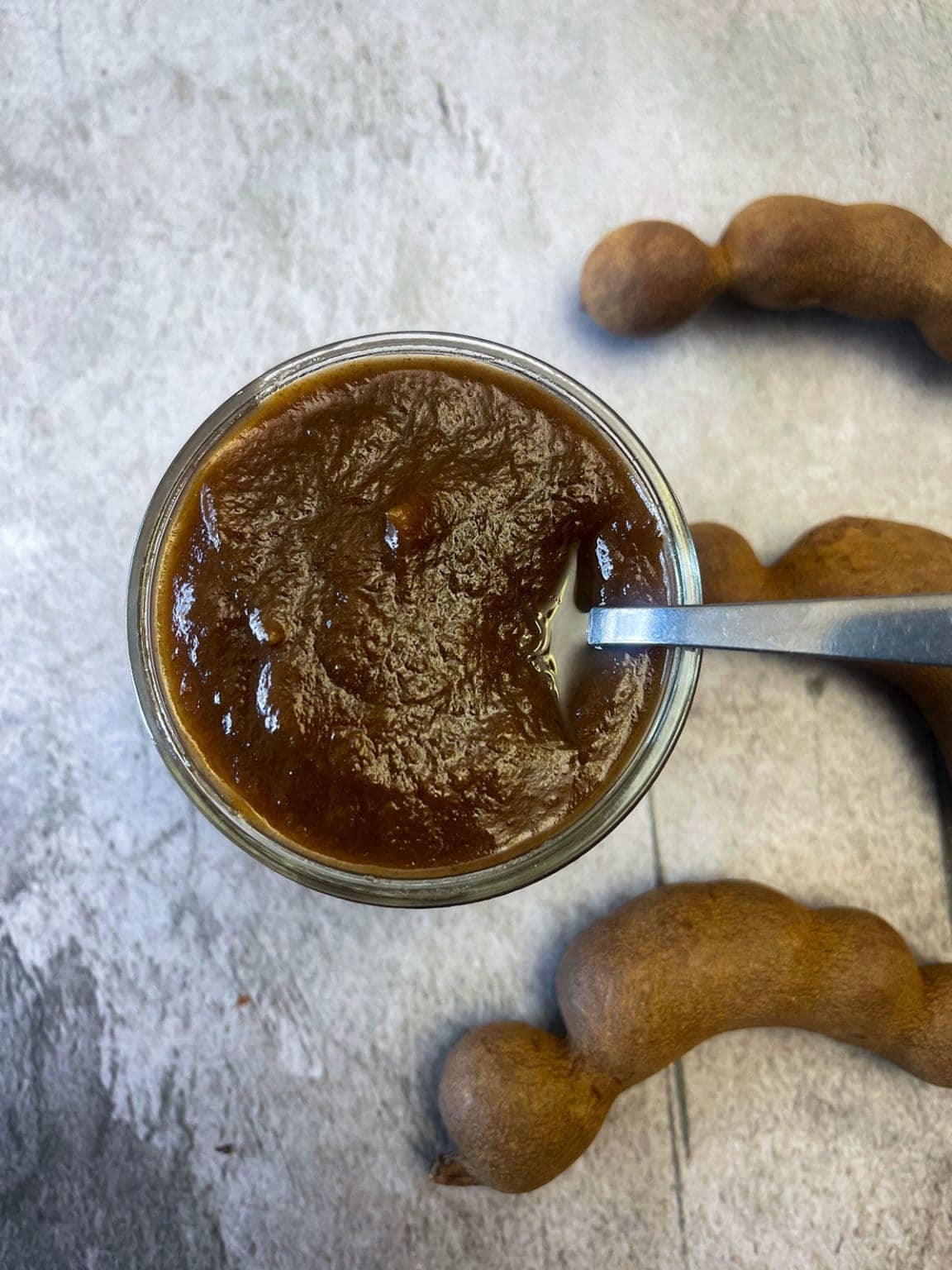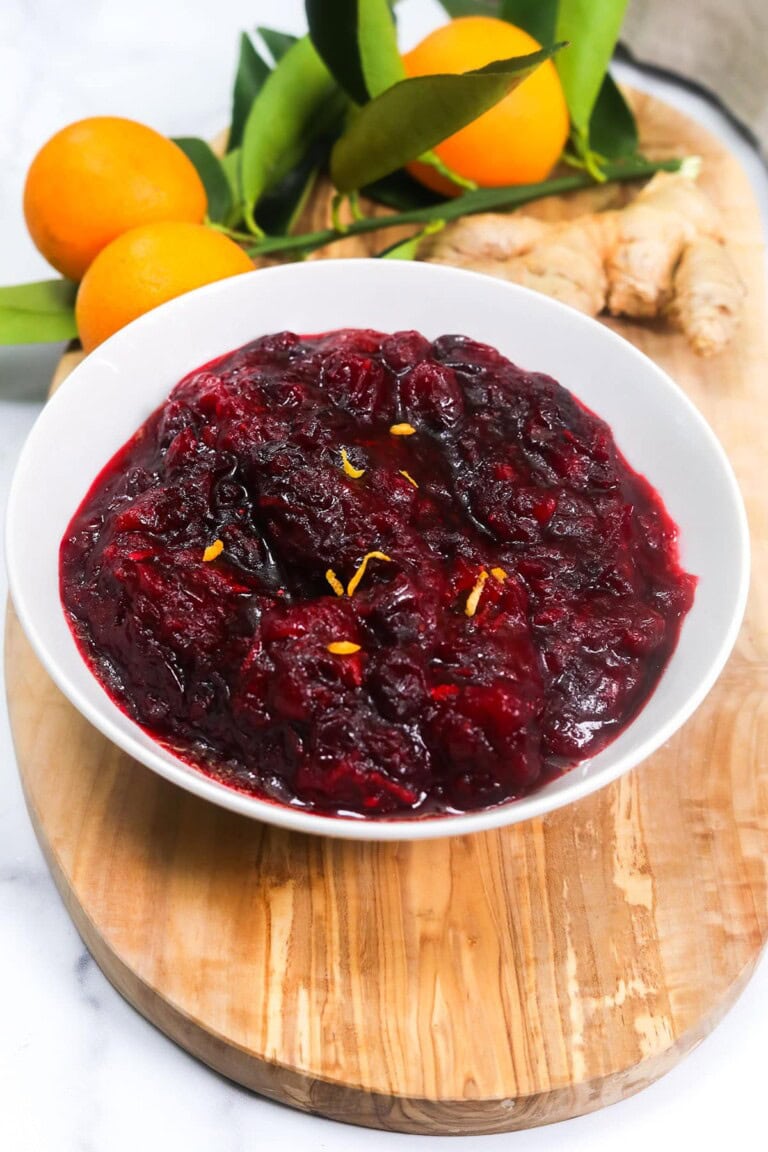Tamarind Date Chutney (No Added Sugar)
The tamarind date chutney in this recipe is so good, you’ll want to lick your fingers! Tamarind chutney pairs perfectly with snacks such as fritters, samosas, rolls, or anything fried or baked.
Originally published May 18th, 2022.
Tamarind Date Chutney
Traditionally, tamarind chutney is sweet and tangy – it is traditionally made from tamarind pulp, jaggery, and spices.
However, I decided to use pitted dates as the sweetener of choice. I recently decided to eliminate added sugar from my diet and I no longer have the desire for it.
The texture of this tamarind chutney is smooth and slightly thick. Besides the sourness of the tamarind, it is sweetened with dates, along with earthiness and mild heat, thanks to cayenne pepper and ginger.
Dahi vadas, samosa chaats, aloo tikki chaats, etc. are often served with this tamarind chutney. Additionally, it is also served with samosa, kachori, pani puri, and pakora.
It keeps well for 10 days when stored in an airtight bottle in the fridge.
Store-bought tamarind pods are easily available in Indian grocery stores, so I always make this chutney with them. You must adjust the quantities of water based on the tartness of the concentrate or paste.
Also see: Tamarind Juice, Tamarind Balls, and Tamarind Sauce!

What Is Tamarind?
Known scientifically as Tamarindus indica, Tamarind is a hardwood tree.
The paste is made from tamarind fruits, which grow in a pod on the tamarind tree. It is native to Africa, but grows in other tropical regions as well, including India and Pakistan.
While tamarind paste is used in some cuisines for desserts and candies, it is mostly used in Thai cuisine for savory dishes, and is also found in Indian curries.
Tamarind is used in traditional pad Thai sauce, as well as in some Thai curries and seafood dishes. Additionally, it is used widely in Indian, Mexican, and Latin American cuisines.
In fact, the distinctive tang of Worcestershire sauce comes from this ingredient.
Health Benefits of Tamarind
Tamarind is a nutritional powerhouse that offers a multitude of health benefits. First and foremost, tamarind is rich in essential vitamins and minerals, such as vitamin C, B vitamins, calcium, and iron, which are crucial for maintaining overall health and vitality.
Its high vitamin C content helps boost the immune system, promoting resistance to illnesses and infections.
Moreover, tamarind contains potent antioxidants, including polyphenols and flavonoids, which combat harmful free radicals in the body, reducing the risk of chronic diseases like cancer and heart disease.
Furthermore, tamarind is celebrated for its digestive properties. It contains natural compounds, like dietary fiber and organic acids, that aid in digestion and alleviate common gastrointestinal issues.
Tamarind can help relieve constipation and promote regular bowel movements, leading to improved gut health.
Its natural laxative properties make it a popular choice for natural remedies to combat digestive discomfort.
In addition, tamarind’s anti-inflammatory properties have been linked to reducing joint pain and inflammation, making it a valuable addition to an active and healthy lifestyle.
With its wide array of health benefits, tamarind is an excellent choice for those looking to enhance their well-being through natural and nutritious dietary choices.
How Is Tamarind Used?
The fruit is used for a variety of purposes, including food preparation, health, and household care.
In South and Southeast Asia, Mexico, the Middle East, and the Caribbean, tamarind pulp is widely used as a food ingredient. Its seeds and leaves can also be eaten.
Various foods and drinks are prepared with it, including sauces, marinades, chutneys, and desserts. It is also a component of Worcestershire sauce.
How To Make Tamarind Paste?
- 3 cups of tamarind pods
- Boiling water to cover
Remove the shells from the tamarind and place them in a bowl. Add boiling water to soak for 30 minutes to soften the flesh.
Add tamarind to a fine-meshed strainer. Place the strainer over a bowl and using the back of a large spoon, press and rub the tamarind to release the pulp from the seeds and stringy fiber.
The pulp will pass through the strainer while the seed and stringy fiber remain in the strainer.
Your tamarind paste is ready to be used in all your favorite recipes or placed into ice cube trays and freeze them.

Tamarind Date Chutney Recipe:
This is a sweet and sour chutney made with tamarind, dates, and ginger. This is my favorite version as it goes along with almost anything and everything.
Ingredients
Tamarind Pulp/Tamarind Concentrate – 1/4 cup tamarind paste is equivalent to 1 tablespoon tamarind concentrate. You can either buy ready-made tamarind pulp from the store, or soak tamarind in warm water, deseed, and squeeze out the pulp.
Dates add the perfect amount of sweetness.
Fresh Ginger – Very fragrant, helps with digestion.
Cumin – Again bring out a beautiful flavor and aroma, and helps with digestion.
Cayenne Peppers– Brings a perfect balance to sweetness from the jaggery and sourness from the tamarind.
Salt – You can use a combo of black and pink salt, I only use pink salt.
How to Make Tamarind Date Chutney?
- The process is very quick and easy if you are using store-bought tamarind plum.
- Put the tamarind pulp or concentrate, dates, ginger, cumin, cayenne pepper, salt, and water in a high-speed blender. Process until smooth.
- Spoon chutney into a saucepan on medium heat. Reduce heat to simmer for 3-5 minutes, stirring constantly.
- Once the water has been reduced and the chutney has reached a smooth glossy consistency, turn off the flame.
- You can keep a balance between the sourness and sweetness with a hint of heat from the cayenne.

Tamarind Chutney Recipe Variations:
Tamarind and Mint Chutney: One of my all-time favorite chutneys, very tangy and spicy with the right balance.
- Take a bunch of mint leaves and half a bunch of cilantro.
- A few green chilies, according to the heat one can handle.
- A few cloves of fresh garlic.
This time we need tamarind water, i.e. some tamarind pulp diluted in water. Also, some dates, salt, and roasted cumin.
Then, blend all of these ingredients in a blender! It’s spicy, tangy, fresh, and a teeny bit sweet from the dates.
Tips for Making Chutneys
Consistency: Chutney’s consistency can be adjusted easily. Depending on your preference, you can make the tamarind chutney slightly thick or thin by alternating the amount of water.
Quality: Make sure you use fresh ingredients. Tamarind that has been aged will have a very different taste and a very dark color.
How to Store Tamarind Chutney?
- Chutney should be stored in a clean, sterilized glass jar. It can be stored in the refrigerator for a week.
- Make sure the jar is not contaminated with moisture or used spoons.
- In the freezer, you can store up to six months.
- Chutney made with fresh mint and tamarind cannot be stored for more than a week.
Other Condiment Recipes:
- Garlic Red Chili Chutney
- Mint Cilantro Chutney
- Curry Simmer Sauce
- Jamaican Jerk Sauce
- Vegan Cheese Sauce
- Vegan Spaghetti Sauce
- Healthy Pizza Sauce

If you enjoyed this Tamarind Date Chutney recipe and would love to see more, join me on Youtube, Instagram, Facebook & Twitter!
Get discounted copies of my cookbook here.
Fortunately, because of the ads on our website, readers and subscribers of Healthier Steps are sponsoring many underprivileged families. Thank you!
Also, please leave a star rating! ;-)
Want to Save This Recipe?
Enter your email & I’ll send it to your inbox. Plus, get great new recipes from me every week!
By submitting this form, you consent to receive emails from Healthier Steps.

Tamarind Date Chutney (No Added Sugar)
Ingredients
- 1 cup pitted dates
- 1/4 cup tamarind paste or 1 tablespoon tamarind concentrate
- 1 teaspoon fresh ginger
- 1/4 teaspoon Cayenne pepper
- Pinch of salt
- 1 1/2 cups water
Instructions
- The process is very quick and easy if you are using store-bought tamarind plum.
- Put the tamarind pulp or concentrate, dates, ginger, cumin, cayenne pepper, salt, and water in a high-speed blender. Process until smooth.
- Spoon chutney into a saucepan on medium heat. Reduce heat to simmer for 5-10 minutes, stirring constantly.
- Once the water has been reduced and the chutney has reached a smooth glossy consistency, turn off the flame.
- You can keep a balance between the sourness and sweetness with a hint of heat from the cayenne.








Thank you Michelle I love so much tamarind Datae chutney
Hi Michelle! I really like tamarind chutney and wondered how to make it. I have tamarind paste now as a while ago I tried to make my own and it was so much work and a mess. :-) I buy the paste now. You forgot to put the dates in the instructions but it is easy to figure it out. Thank you for this great recipe. Your cookbook is wonderful too.
Marie, thank you very much for letting me know my mistake. Many times I’m posting just before bed and end up making mistakes. Yes, it is a lot of work. Most times I end up just eating the fresh tamarinds and using the storebought paste instead. I’m happy you love my cookbook, I plan to do another one soon. I’m going to update the recipe instructions now. Thank you Marie.